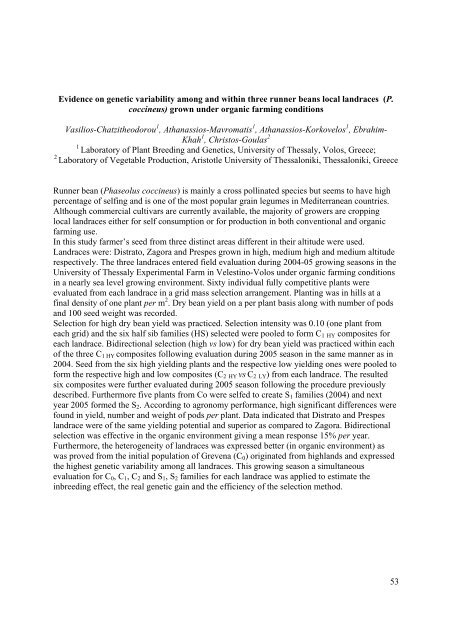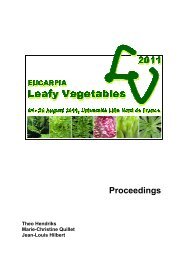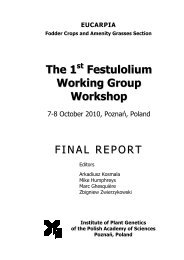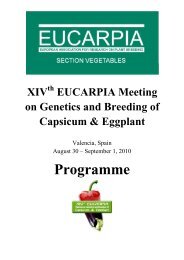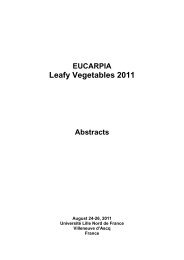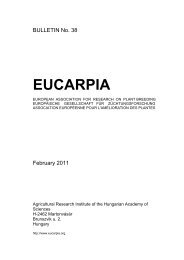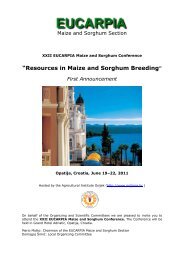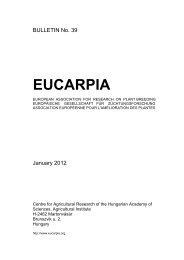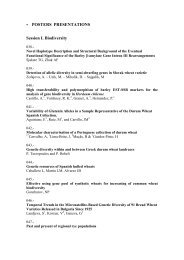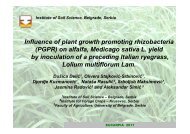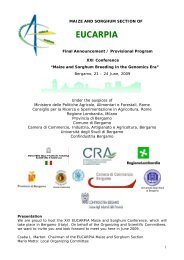Plant breeding for organic and sustainable, low-input agriculture
Plant breeding for organic and sustainable, low-input agriculture
Plant breeding for organic and sustainable, low-input agriculture
Create successful ePaper yourself
Turn your PDF publications into a flip-book with our unique Google optimized e-Paper software.
Evidence on genetic variability among <strong>and</strong> within three runner beans local l<strong>and</strong>races (P.<br />
coccineus) grown under <strong>organic</strong> farming conditions<br />
Vasilios-Chatzitheodorou 1 , Athanassios-Mavromatis 1 , Athanassios-Korkovelos 1 , Ebrahim-<br />
Khah 1 , Christos-Goulas 2<br />
1 Laboratory of <strong>Plant</strong> Breeding <strong>and</strong> Genetics, University of Thessaly, Volos, Greece;<br />
2 Laboratory of Vegetable Production, Aristotle University of Thessaloniki, Thessaloniki, Greece<br />
Runner bean (Phaseolus coccineus) is mainly a cross pollinated species but seems to have high<br />
percentage of selfing <strong>and</strong> is one of the most popular grain legumes in Mediterranean countries.<br />
Although commercial cultivars are currently available, the majority of growers are cropping<br />
local l<strong>and</strong>races either <strong>for</strong> self consumption or <strong>for</strong> production in both conventional <strong>and</strong> <strong>organic</strong><br />
farming use.<br />
In this study farmer’s seed from three distinct areas different in their altitude were used.<br />
L<strong>and</strong>races were: Distrato, Zagora <strong>and</strong> Prespes grown in high, medium high <strong>and</strong> medium altitude<br />
respectively. The three l<strong>and</strong>races entered field evaluation during 2004-05 growing seasons in the<br />
University of Thessaly Experimental Farm in Velestino-Volos under <strong>organic</strong> farming conditions<br />
in a nearly sea level growing environment. Sixty individual fully competitive plants were<br />
evaluated from each l<strong>and</strong>race in a grid mass selection arrangement. <strong>Plant</strong>ing was in hills at a<br />
final density of one plant per m 2 . Dry bean yield on a per plant basis along with number of pods<br />
<strong>and</strong> 100 seed weight was recorded.<br />
Selection <strong>for</strong> high dry bean yield was practiced. Selection intensity was 0.10 (one plant from<br />
each grid) <strong>and</strong> the six half sib families (HS) selected were pooled to <strong>for</strong>m C1 HY composites <strong>for</strong><br />
each l<strong>and</strong>race. Bidirectional selection (high vs <strong>low</strong>) <strong>for</strong> dry bean yield was practiced within each<br />
of the three C1 HY composites fol<strong>low</strong>ing evaluation during 2005 season in the same manner as in<br />
2004. Seed from the six high yielding plants <strong>and</strong> the respective <strong>low</strong> yielding ones were pooled to<br />
<strong>for</strong>m the respective high <strong>and</strong> <strong>low</strong> composites (C2 HY vs C2 LY) from each l<strong>and</strong>race. The resulted<br />
six composites were further evaluated during 2005 season fol<strong>low</strong>ing the procedure previously<br />
described. Furthermore five plants from Co were selfed to create S1 families (2004) <strong>and</strong> next<br />
year 2005 <strong>for</strong>med the S2. According to agronomy per<strong>for</strong>mance, high significant differences were<br />
found in yield, number <strong>and</strong> weight of pods per plant. Data indicated that Distrato <strong>and</strong> Prespes<br />
l<strong>and</strong>race were of the same yielding potential <strong>and</strong> superior as compared to Zagora. Bidirectional<br />
selection was effective in the <strong>organic</strong> environment giving a mean response 15% per year.<br />
Furthermore, the heterogeneity of l<strong>and</strong>races was expressed better (in <strong>organic</strong> environment) as<br />
was proved from the initial population of Grevena (C0) originated from highl<strong>and</strong>s <strong>and</strong> expressed<br />
the highest genetic variability among all l<strong>and</strong>races. This growing season a simultaneous<br />
evaluation <strong>for</strong> C0, C1, C2 <strong>and</strong> S1, S2 families <strong>for</strong> each l<strong>and</strong>race was applied to estimate the<br />
in<strong>breeding</strong> effect, the real genetic gain <strong>and</strong> the efficiency of the selection method.<br />
53


